formerly eScholarship Editions


|
|
|
|
Your search for
'Art' in subject
found 84 book(s). | Modify Search | Displaying 21 - 40 of 84 book(s) | |
| 21. | 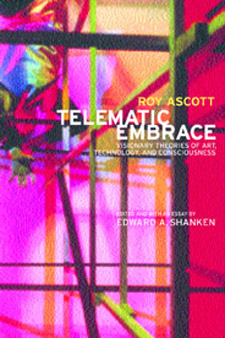 | Title: Telematic embrace: visionary theories of art, technology, and consciousness Author: Ascott, Roy Published: University of California Press, 2003 Subjects: Art | Art Theory | Electronic Media Publisher's Description: Long before e-mail and the Internet permeated society, Roy Ascott, a pioneering British artist and theorist, coined the term "telematic art" to describe the use of online computer networks as an artistic medium. In Telematic Embrace Edward A. Shanken gathers, for the first time, an impressive compilation of more than three decades of Ascott's philosophies on aesthetics, interactivity, and the sense of self and community in the telematic world of cyberspace. This book explores Ascott's ideas on how networked communication has shaped behavior and consciousness within and beyond the realm of what is conventionally defined as art. Telematics, a powerful marriage of computers and telecommunication, made technologies we now take for granted - such as e-mail and automated teller machines (ATMs) - part of our daily life, and made art a more interactive form of expression. Telematic art challenges traditional relationships between artist, artwork, and audience by allowing nonlocal audiences to influence the emergent qualities of the artwork, which consists of the ebb and flow of electronic information. These essays constitute a unique archaeology of ideas, tracing Ascott's meditations on the formation of consciousness through the intertwined cultural histories of art and technology from the 1960s to the present. Shanken's introduction situates Ascott's work within a history of ideas in art, technology, and philosophy. Given the increasing role of the Internet and the World Wide Web in the creation of commerce and community at the dawn of this new millennium, scholars, students, laypeople, policymakers, and artists will find this collection informative and thought-provoking. [brief] Similar Items |
| 22. | 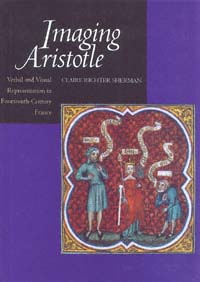 | Title: Imaging Aristotle: verbal and visual representation in fourteenth-century France Author: Sherman, Claire Richter Published: University of California Press, 1995 Subjects: Art | Art History | Medieval Studies Publisher's Description: Nicole Oresme's translation of Aristotle's Nicomachean Ethics, Politics, and Economics into French from Latin in the 1370s is the subject of Claire Sherman's stunningly illustrated book. Though both the text translations and their images have been studied separately, this is the first time they are published in their entirety and considered together.Intended for an audience of Charles V, his counselors, and high-ranking lay people, these manuscripts are significant for their linguistic and political implications, for moving Aristotle's work beyond clerical and university boundaries, and for reflecting the dynamics of monarchic control of French language and culture. Sherman shows the importance of Oresme's role as translator and book designer. She also explores the gender and class representations in the imagery, relating them not only to the views of Oresme and his audience but also to the contemporary secular culture. [brief] Similar Items |
| 23. | 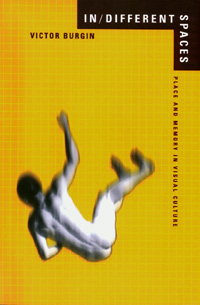 | Title: In/different spaces: place and memory in visual culture Author: Burgin, Victor Published: University of California Press, 1996 Subjects: Art | Art Criticism | Social Science Publisher's Description: Recent discussions about the culture of images have focused on issues of identity - sexual, racial, national - and the boundaries that define subjectivity. In this context Victor Burgin adopts an original critical strategy. He understands images less in traditional terms of the specific institutions that produce them, such as cinema, photography, advertising, and television, and more as hybrid mental constructs composed of fragments derived from the heterogeneous sources that together constitute the "media." Through deft analyses of a photograph by Helmut Newton, Parisian cityscapes, the space of the department store, a film by Ousmane Sembéne, and the writings of Henri Lefebvre, Andrè Breton, and Roland Barthes, Burgin develops an incisive theory of our culture of images and spectacle. In/Different Spaces explores the construction of identities in the psychical space between perception and consciousness, drawing upon psychoanalytic theories to describe the constitution and maintenance of "self" and "us" - in imaginary spatial and temporal relations to "other" and "them" - through the all-important relay of images. For Burgin, the image is never a transparent representation of the world but rather a principal player on the stage of history. [brief] Similar Items |
| 24. | 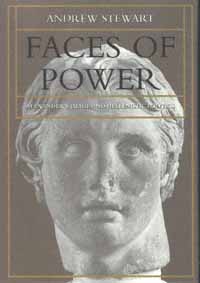 | Title: Faces of power: Alexander's image and Hellenistic politics Author: Stewart, Andrew F Published: University of California Press, 1994 Subjects: Art | Art and Architecture Publisher's Description: Alexander the Great changed the face of the ancient world. During his life and after his death, his image in works of art exerted an unprecedented influence?on marbles, bronzes, ivories, frescoes, mosaics, coins, medals, even painted pottery and reliefware. Alexander's physiognomy became the most famous in history. But can we really know what meaning lies behind these images?Andrew Stewart demonstrates that these portraits - wildly divergent in character, quality, type, provenance, date, and purpose - actually transmit not so much a likeness of Alexander as a set of carefully crafted clichés that mobilize the notion "Alexander" for diverse ends and diverse audiences. Stewart discusses the portraits as studies in power and his original interpretation of them gives unprecedented fullness and shape to the idea and image called "Alexander." [brief] Similar Items |
| 25. | 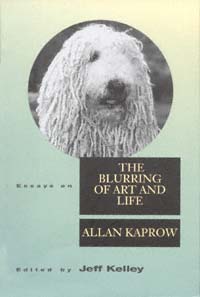 | Title: Essays on the blurring of art and life Author: Kaprow, Allan Published: University of California Press, 1993 Subjects: Art | Art Criticism | Art Theory Publisher's Description: As the creator of "Happenings" and "Environments," Allan Kaprow is the prince and prophet of all we call performance art today. He is also known for having written some of the most thoughtful, provocative, and influential essays of his generation. From "The Legacy of Jackson Pollock" in 1958 to "The Meaning of Life" in 1990, Kaprow has conducted a sustained philosophical inquiry into the paradoxical relationship of art to life, and thus into the nature of meaning itself. With the publication of this book, twenty-three of Kaprow's most significant essays are brought together in one volume for the first time.Kaprow charts his own evolution as an artist and also comments on contemporaneous developments in the arts. From the modernist avant-garde of the fifties to the current postmodern fin de siècle , Kaprow has written about - and from within - the shifting, blurring boundaries of genre, media, culture, and experience. Edited and introduced by critic Jeff Kelley, these essays bring into crisp focus the thinking of one of the most influential figures in the varied landscape of American art since the late 1950s. [brief] Similar Items |
| 26. | 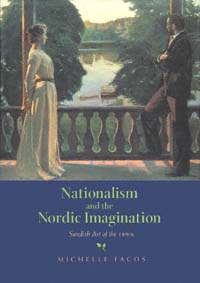 | Title: Nationalism and the Nordic imagination: Swedish art of the 1890s Author: Facos, Michelle Published: University of California Press, 1998 Subjects: Art | Art History | European Studies Publisher's Description: This richly illustrated book is a lucid introduction to a largely neglected manifestation of Modernism that came out of fin-de-siècle Sweden. Michelle Facos presents the first study in English to seriously examine the movement known as Swedish National Romanticism. Her work is especially valuable in showing how the movement's primitivist tendencies were related to, but different from, similar cultural forces in Germany and other parts of Europe at that time. Facos shows how a small group of Swedish artists espoused a politically progressive, culturally conservative form of nationalism. These artists - among them Carl Larsson, Bruno Liljefors, and Hanna Hirsch Pauli - produced a specifically national Swedish art by focusing on indigenous history, legends, and folk tales as well as uniquely Swedish-Nordic values, geography, and ethnography. Their breathtaking images of the Nordic landscape shaped a communal "Folk" identity that accented regionalism, solidarity, and attachment to the past and protested against the perceived dangers of capitalist industrialism and urban expansion. By 1900 Sweden was on its way to realizing a society of social, economic, and political equality, and the National Romantic painters were no longer renegades. Facos's portrayal of their movement will attract readers in the arts, historians, folklorists, cultural anthropologists, and sociologists. [brief] Similar Items |
| 27. | 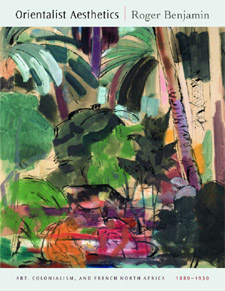 | Title: Orientalist aesthetics: art, colonialism, and French North Africa, 1880-1930 Author: Benjamin, Roger 1957- Published: University of California Press, 2003 Subjects: Art | Art History | French Studies Publisher's Description: Lavishly illustrated with exotic images ranging from Renoir's forgotten Algerian oeuvre to the abstract vision of Matisse's Morocco and beyond, this book is the first history of Orientalist art during the period of high modernism. Roger Benjamin, drawing on a decade of research in untapped archives, introduces many unfamiliar paintings, posters, miniatures, and panoramas and discovers an art movement closely bound to French colonial expansion. Orientalist Aesthetics approaches the visual culture of exoticism by ranging across the decorative arts, colonial museums, traveling scholarships, and art criticism in the Salons of Paris and Algiers. Benjamin's rediscovery of the important Society of French Orientalist Painters provides a critical context for understanding a lush body of work, including that of indigenous Algerian artists never before discussed in English. The painter-critic Eugène Fromentin tackled the unfamiliar atmospheric conditions of the desert, Etienne Dinet sought a more truthful mode of ethnographic painting by converting to Islam, and Mohammed Racim melded the Persian miniature with Western perspective. Benjamin considers armchair Orientalists concocting dreams from studio bric-à-brac, naturalists who spent years living in the oases of the Sahara, and Fauve and Cubist travelers who transposed the discoveries of the Parisian Salons to create decors of indigenous figures and tropical plants. The network that linked these artists with writers and museum curators was influenced by a complex web of tourism, rapid travel across the Mediterranean, and the march of modernity into a colonized culture. Orientalist Aesthetics shows how colonial policy affected aesthetics, how Europeans visualized cultural difference, and how indigenous artists in turn manipulated Western visual languages. [brief] Similar Items |
| 28. | 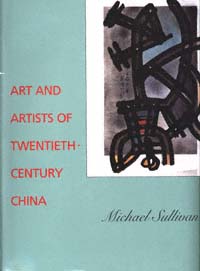 | Title: Art and artists of twentieth-century China Author: Sullivan, Michael 1916- Published: University of California Press, 1996 Subjects: Art | Art History | China Publisher's Description: This visually stunning book focuses on the rebirth of Chinese art in the twentieth century under the influence of Western art and culture. Michael Sullivan, recognized throughout the world as a leading scholar of Chinese art, vividly documents the conflicting pulls of traditional and Western values on Chinese art and provides 364 illustrations, in color and black-and-white, to show the great range of artistic expression and the historical processes that occurred within various movements. A substantial biographical index of twentieth-century Chinese artists is a valuable addition to the text.Sullivan discusses artists and their work against China's background of oppression and relaxation, despair and hope. He expertly conveys the diverse and at times bizarre intertwining of Chinese cultural history and art during this century. Included are the intense debates between traditionalists and reformers, the creation of the first art schools, and the birth of the idea - shocking in ethnocentric China - that art is a world language that obliterates all frontiers. The scholarly traditions of classical Chinese painting, the belated discovery of Western modernism, the artistic upheaval under Communism, and China's rethinking of the very nature of art all have a place in Sullivan's fascinating history.Michael Sullivan has known many of the major figures in China's modern art movement of the 1930s and 1940s and has also gained the confidence of younger artists who rose to prominence following the 1979 "Peking Spring." This long-awaited book - richly documented and abundantly illustrated - is a capstone to Sullivan's work and will be enthusiastically welcomed by art lovers everywhere. [brief] Similar Items |
| 29. | 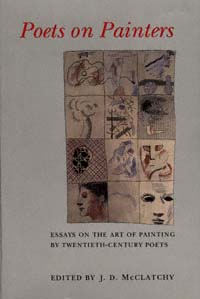 | Title: Poets on painters: essays on the art of painting by Twentieth-century poets Author: McClatchy, J. D 1945- Published: University of California Press, 1989 Subjects: Literature | Art | Poetry | Art History Publisher's Description: What are poets looking at , looking for , when they walk into a room of pictures? Poets on Painters attempts to answer this question by bringing together, for the first time, essays by modern American and British poets about painting. The poets bring to their task a fresh eye and a freshened languag . . . [more] Similar Items |
| 30. | 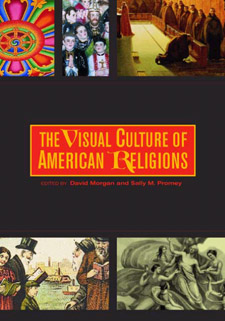 | Title: The visual culture of American religions Author: Morgan, David 1957- Published: University of California Press, 2001 Subjects: Religion | Art | American Studies Publisher's Description: Contemporary artists have often clashed with conservative American evangelicals in recent years, giving the impression that art and religion are fundamentally at odds. Yet historically, artistic images have played a profound role in American religious life. This superb collection of essays, with its unique assembly of images, challenges the apparent tension between religion and the arts by illustrating and investigating their long-standing and intriguing relationship from the early nineteenth century to the present day. The essays explore such varied topics as Sioux Sun Dance artifacts and paintings, American Jewish New Year postcards, the New Mexican santos tradition, roadside shrines, images of journey in African American pictorial traditions, the public display of religion, and the religious use of nineteenth-century technologies of mass reproduction. [brief] Similar Items |
| 31. | 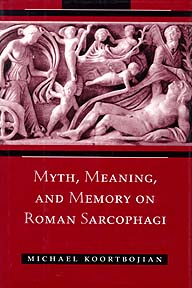 | Title: Myth, meaning, and memory on Roman sarcophagi Author: Koortbojian, Michael Published: University of California Press, 1995 Subjects: Classics | Art | Art History | Art and Architecture Publisher's Description: Michael Koortbojian brings a novel approach to his study of the role of Greek mythology in Roman funerary art. He looks at two myths - Aphrodite and Adonis and Selene and Endymion - not only with respect to their appearance on Roman sarcophagi, but also with regard to the myths' significance in the greater fabric of Roman life. Moving beyond the examination of these sarcophagi as artistic achievements, he sets them in their broader historical and social contexts.Remembrance was an important factor in ancient social life and fueled the need for memorials. In helping us to understand the powerful allusions that Greek myths presented for the Romans, and the role of those allusions in preserving the memory of the dead, Koortbojian effectively widens our vision of the ancient world. [brief] Similar Items |
| 32. | 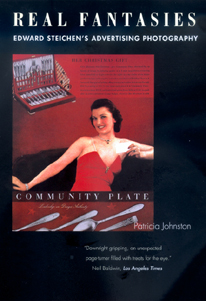 | Title: Real fantasies: Edward Steichen's advertising photography Author: Johnston, Patricia A 1954- Published: University of California Press, 1997 Subjects: Art | Art History | History | Cultural Anthropology Publisher's Description: During the 1920s and 1930s, Edward Steichen was the most successful photographer in the advertising industry. Although much has been said about Steichen's fine-art photography, his commercial work - which appeared regularly in Vanity Fair, Vogue, Ladies Home Journal , and almost every other popular magazine published in the United States - has not received the attention it deserves. At a time when photography was just beginning to replace drawings as the favored medium for advertising, Steichen helped transform the producers of such products as Welch's grape juice and Jergens lotion from small family businesses to national household names. In this book, Patricia Johnston uses Steichen's work as a case study of the history of advertising and the American economy between the wars. She traces the development of Steichen's work from an early naturalistic style through increasingly calculated attempts to construct consumer fantasies. By the 1930s, alluring images of romance and class, developed in collaboration with agency staff and packaged in overtly manipulative and persuasive photographs, became Steichen's stock-in-trade. He was most frequently chosen by agencies for products targeted toward women: his images depicted vivacious singles, earnest new mothers, and other stereotypically female life stages that reveal a great deal about the industry's perceptions of and pitches to this particular audience.Johnston presents an intriguing inside view of advertising agencies, drawing on an array of internal documents to reconstruct the team process that involved clients, art directors, account executives, copywriters, and photographers. Her book is a telling chronicle of the role of mass media imagery in reflecting, shaping, and challenging social values in American culture. [brief] Similar Items |
| 33. | 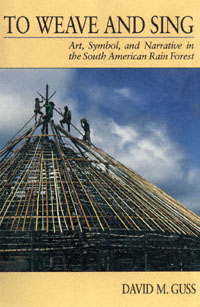 | Title: To weave and sing: art, symbol, and narrative in the South American rainforest Author: Guss, David M Published: University of California Press, 1990 Subjects: Anthropology | Cultural Anthropology | Art | Latin American Studies Publisher's Description: To Weave and Sing is the first in-depth analysis of the rich spiritual and artistic traditions of the Carib-speaking Yekuana Indians of Venezuela, who live in the dense rain forest of the upper Orinoco. Within their homeland of Ihuruna, the Yekuana have succeeded in maintaining the integrity and unity of their culture, resisting the devastating effects of acculturation that have befallen so many neighboring groups. Yet their success must be attributed to more than natural barriers of rapids and waterfalls, to more than lack of "contact" with our "modern" world. The ethnographic history recounted here includes not only the Spanish discovery of the Yekuana but detailed indigenous accounts of the entire history of Yekuana contact with Western culture, revealing an adaptive technique of mythopoesis by which the symbols of a new and hostile European ideology have been consistently defused through their incorporation into traditional indigenous structures.The author's initial point of departure is the Watunna , the Yekuana creation epic, but he finds his principal entrance into this mythic world through basketry, focusing on the eleborate kinetic designs of the round waja baskets and the stories told about them. Guss argues that the problem of understanding Yekuana basketry is the problem of understanding all traditional art forms within a tribal context, and critiques the cultural assumptions inherent in our systems of classification. He demonstrates that the symbols woven into the baskets function not in isolation but collectively, as a powerful system cutting across the entire culture. To Weave and Sing addresses all Yekuana material culture and the greater reality it both incorporates and masks, discerning a unifying configuration of symbols in chapters on architectural forms, the geography of the body, and the use of herbs, face paints, and chants. A narrow view of slash-and-burn gardens as places of mere subsistence is challenged by Guss's portrait of these exclusively female spaces as systematic inversions of the male world, "the sacred turned on its head." Throughout, a wealth of narrative and ritual materials provides us with the closest approximation we have to a native exegesis of these phenomena. What we are offered here is a new Poetics of Culture, ethnography not as a static given but as a series of shifting fields, wherein culture (and our image of it) is constantly recreated in all of its parts, by all of its members. [brief] Similar Items |
| 34. | 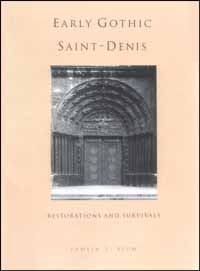 | Title: Early Gothic Saint-Denis: restorations and survivals Author: Blum, Pamela Z Published: University of California Press, 1992 Subjects: Art | Architectural History | Art History | Medieval Studies | Archaeology Publisher's Description: quality. Indeed, the well-preserved sculptural passages provide a key to the Early Gothic style as well as revealing the distinct imprints of three artists and their influences on each other. Blum's penetrating analyses of the restorative techniques and materials are accompanied by telling photograph-diagrams that distinguish the original work from that done later.Pamela Blum's investigation has relevance not only for students and scholars of medieval art but for curators and collectors as well. Anyone concerned with survivals from the past will appreciate her scrupulous detection in studying one of France's greatest monuments. [brief] Similar Items |
| 35. | 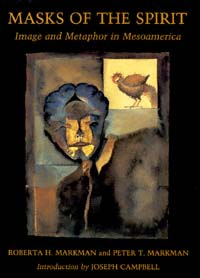 | Title: Masks of the spirit: image and metaphor in Mesoamerica Author: Markman, Peter T Published: University of California Press, 1990 Subjects: Anthropology | Art | Folklore and Mythology Similar Items |
| 36. | 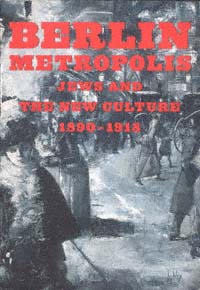 | Title: Berlin metropolis: Jews and the new culture, 1890-1918 Author: Bilski, Emily D 1956- Published: University of California Press, 2000 Subjects: Art | History | Jewish Studies | German Studies Publisher's Description: Between 1890 and 1918 the city of Berlin evolved into a commercial and industrial hub that also became an international center for radical new ideas in the visual, performing, and literary arts. Jews were key leaders in developing this unique cosmopolitan culture. Berlin Metropolis: Jews and the New Culture, 1890-1918 vividly documents the many ways that Jewish artists and entrepreneurs participated in this burst of artistic creativity and promoted the emergence of modernism on the international scene.The book and exhibition at The Jewish Museum highlight leading cultural figures such as Max Liebermann, a founder of the Berlin Secession, and Herwarth Walden, who founded Der Sturm; artists such as Ludwig Meidner and Jakob Steinhardt; pioneers of cabaret, theater, and film, including Max Reinhardt and Ernst Lubitsch; art dealers, publishers, and writers; and leading intellectual and political figures such as Martin Buber and Georg Simmel. These and other fascinating individuals are represented by more than 200 diverse objects: paintings, sculpture, drawings, prints, books, letters, posters, graphic arts, theater memorabilia, and film. The book includes eight essays by scholars of German and Jewish culture and art history that provide a truly interdisciplinary interpretation of the Berlin renaissance.The period represented in Berlin Metropolis was a time when Jews were traditionally restricted from participating in major areas of German public life such as the army, government, and the university. But by turning to the "alternative public spheres" characteristic of urban society - galleries, cafés, journals, theaters, cabarets - they emerged as innovative cultural leaders whose intellectual and artistic impact is still felt today.The exhibition, Berlin Metropolis: Jews and the New Culture, 1890-1918 , will be at The Jewish Museum, New York , from November 14, 1999, to March 5, 2000; and the Norton Museum of Art, West Palm Beach, Florida , from April 1 to June 11, 2000. [brief] Similar Items |
| 37. | 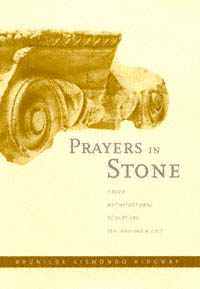 | Title: Prayers in stone: Greek architectural sculpture ca. 600-100 B.C.E Author: Ridgway, Brunilde Sismondo 1929- Published: University of California Press, 1999 Subjects: Classics | Art | Art and Architecture | Art History Publisher's Description: The meaning of architectural sculpture is essential to our understanding of ancient Greek culture. The embellishment of buildings was common for the ancient Greeks, and often provocative. Some ornamental sculpture was placed where, when the building was finished, no mortal eye could view it. And unlike much architectural ornamentation of other cultures, Greek sculpture was often integral to the building, not just as decoration, and could not be removed without affecting the integrity of the building structure. This book is the first comprehensive treatment of the significance of Greek architectural sculpture. Brunilde Sismondo Ridgway, a world-class authority on ancient Greek sculpture, provides a highly informative tour of many dimensions of Greek public buildings - especially temples, tombs, and treasuries - in a text that is at once lucid, accessible, and authoritative.Ridgway's pragmatism and common sense steer us tactfully and clearly through thickets of uncertainty and scholarly disagreement. She refers to a huge number of monuments, and documents her discussions with copious and up-to-date bibliographies. This book is sure to be acknowledged at once as the standard treatment of its important topic. [brief] Similar Items |
| 38. | 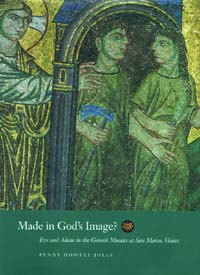 | Title: Made in God's image?: Eve and Adam in the Genesis mosaics at San Marco, Venice Author: Jolly, Penny Howell Published: University of California Press, 1997 Subjects: Art | Art History | Medieval Studies | Women's Studies | Religion Publisher's Description: The stunning mosaics that illustrate the story of Creation in the church of San Marco in Venice are the focus of Penny Howell Jolly's compelling and provocative book. Scholars of medieval art have long been interested in the Genesis mosaics because they copy a nearly destroyed fifth-century illuminated Greek manuscript known as the Cotton Genesis. But instead of seeing the mosaics as a vehicle for reconstructing a lost cycle of paintings, Jolly presents them as a social document revealing the essential misogyny that existed in thirteenth-century Venice. Jolly analyzes more than twenty scenes, one by one in narrative order, and her perceptive reading goes well beyond what the Genesis Vulgate text says about Eve and Adam. The mosaics establish Eve as the culpable character from the very moment of her Creation, says Jolly, and depict her as dangerous and unrepentant at the end. Incorporating both feminist religious and narratological studies, Jolly poses important questions on the nature of visual language as opposed to verbal language. The very ability of visual forms to recall a rich variety of references is one source of their power, and propaganda must have enough breadth of reference to be read by diverse groups. The San Marco cupola, Jolly maintains, is dealing in powerful propaganda, and her pictorial observations offer an articulate and refreshing new view of this well-known work. [brief] Similar Items |
| 39. | 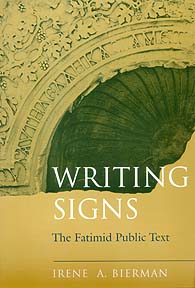 | Title: Writing signs: the Fatimid public text Author: Bierman, Irene A Published: University of California Press, 1998 Subjects: Art | Middle Eastern Studies | Middle Eastern History | Literature Publisher's Description: Irene Bierman explores the complex relationship between alphabet and language as well as the ways the two elements are socially defined by time and place. She focuses her exploration on the Eastern Mediterranean in the sixth through twelfth centuries, notably Cairo's Fatimid dynasty of 969-1171. Examining the inscriptions on Fatimid architecture and textiles, Bierman offers insight into all elements of that society, from religion to the economy, and the enormous changes the dynasty underwent during that period. Bierman addresses fundamental issues of what buildings mean, how inscriptions affect that meaning, and the role of written messages and the ceremonies into which they are incorporated in service of propagandist goals. Her method and conclusions provide a pioneering model for studying public writing in other societies and offer powerful evidence to show that writing is a highly charged and deeply embedded social practice. [brief] Similar Items |
| 40. | 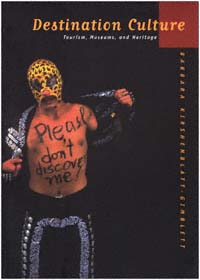 | Title: Destination culture: tourism, museums, and heritage Author: Kirshenblatt-Gimblett, Barbara Published: University of California Press, 1998 Subjects: Art | Art Theory | Popular Culture | Cultural Anthropology | Travel Publisher's Description: Destination Culture takes the reader on an eye-opening journey from ethnological artifacts to kitsch. Posing the question, "What does it mean to show?" Barbara Kirshenblatt-Gimblett explores the agency of display in a variety of settings: museums, festivals, world's fairs, historical re-creations, memorials, and tourist attractions. She talks about how objects - and people - are made to "perform" their meaning for us by the very fact of being collected and exhibited, and about how specific techniques of display, not just the things shown, convey powerful messages. Her engaging analysis shows how museums compete with tourism in the production of "heritage." To make themselves profitable, museums are marketing themselves as tourist attractions. To make locations into destinations, tourism is staging the world as a museum of itself. Both promise to deliver heritage. Although heritage is marketed as something old, she argues that heritage is actually a new mode of cultural production that gives a second life to dying ways of life, economies, and places. The book concludes with a lively commentary on the "good taste/bad taste" debate in the ephemeral "museum of the life world," where everyone is a curator of sorts and the process of converting life into heritage begins. [brief] Similar Items |